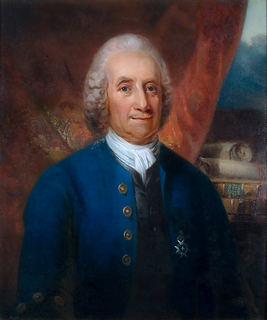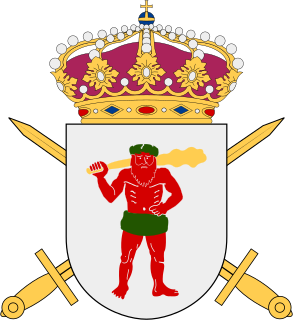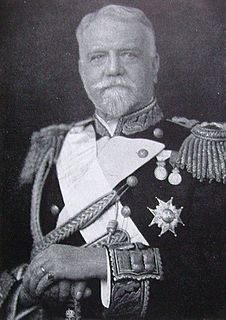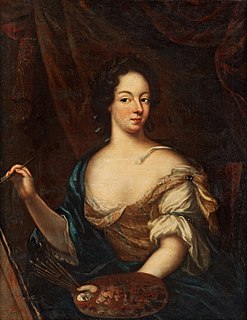The Russo-Swedish War of 1741–1743 was instigated by the Hats, a Swedish political party that aspired to regain the territories lost to Russia during the Great Northern War, and by French diplomacy, which sought to divert Russia's attention from supporting its long-standing ally the Habsburg monarchy in the War of the Austrian Succession. The war was a disaster for Sweden, which lost more territory to Russia.

Emanuel Swedenborg was a Swedish pluralistic-Christian theologian, scientist, philosopher and mystic. He became best known for his book on the afterlife, Heaven and Hell (1758).

The Västerbotten Regiment, designations I 19, I XIX, I 20 and I 20/Fo 61, was a Swedish Army infantry regiment that traced its origins back to the 16th century. The regiment's soldiers were originally recruited from the province of Västerbotten, where it was later garrisoned. The unit was disbanded as a result of the disarmament policies set forward in the Defence Act of 2000.

Adam Ludwig Lewenhaupt was a Swedish general, particularly known for his participation in the Great Northern War.

Carl Gustaf Pilo was a Swedish artist and painter. Pilo worked extensively in Denmark as a painter to the Danish Royal Court and as professor and director at the Royal Danish Academy of Art, as well as in his native Sweden.
Wolmar Anton von Schlippenbach (1653–1721) was Governor General of Swedish Estonia from 1704 to 1706.

Count Carl Gustav Rehnskiöld was a Swedish Field Marshal (Fältmarskalk) and Royal Councillor. He was mentor and chief military advisor to King Charles XII of Sweden, and served as deputy commander-in-chief of the Carolean Army, an army he assisted both in its education and development.

Count Carl Lewenhaupt was a Swedish diplomat and politician, who was Minister for Foreign Affairs from 1889 to 1895.

Count Carl August Ehrensvärd was a Swedish Navy admiral, politician and Minister for Naval Affairs 1907–1911.

Christina Augusta Löwenhielm née von Fersen, was a Swedish countess and courtier. She is known for her love affair with the later Charles XIII of Sweden. She is also famous in history as one of "the three graces" of the Gustavian age; three ladies-in-waiting immortalized in the poem Gracernas döpelse by Johan Henric Kellgren, and known profiles of the epoch.

Carl Henrik Wrangel, friherre Wrangel af Adinal was an officer of the Swedish Army, attaining the rank of Field Marshal.

Henrik Magnus von Buddenbrock was a Swedish baron and Lieutenant General. He and Carl Emil Lewenhaupt were executed for negligence in the Russo-Swedish War, in the aftermath of the defeat at Villmanstrand.

Amalia "Emilie" Wilhelmina Königsmarck was a Swedish noble, known as a dilettante artist (painter), amateur actor, and poet.
Lewenhaupt is the name of an old Swedish noble family and may refer to:
Höffern, von Höffer or von Hoeffer, was a German noblewoman and fortune teller. She became famous in Sweden during the first half of the 18th century, where she has been called the first famous fortune teller in Stockholm.

The Great Stockholm Fire of 1759 was the city’s greatest fire since 1686. It raged in the Eastern Södermalm on Thursday July 19 and over the following night, reduced about 20 blocks with about 300 houses to ash, and rendered about 2000 persons homeless. While no deaths were reported, there were 19 injuries. In Sweden, the fire is named Mariabranden after the Maria Magdalena Church, which was severely damaged. Outside Sweden, the fire is most famous because an occult anecdote claims the scientist and mystic Emanuel Swedenborg by a sort of clairvoyance could ”see” the fire from Gothenburg.

Events from the year 1759 in Sweden

Events from the year 1691 in Sweden

Carl Einar Thure af Wirsén was a Swedish Army officer, diplomat and writer. Originally an officer, he was sent into the diplomatic service after World War I and served as a military attaché in Constantinople and Sofia where he witnessed the Armenian genocide. From the Ottoman Empire and the Balkans, af Wirsén came to Poland and witnessed the country's resurrection. After serving in London, Reval and Riga, he was sent as envoy to Bucharest, Athens and Belgrade in 1921. After working in the Mosul Commission, af Wirsén was sent to Berlin, where he would stay for the next 12 years as envoy. Finally he was envoy in Rome for three years before retiring in 1940.
Count Axel Charles Emil Lewenhaupt was a Swedish diplomat and Grand Master of Ceremonies at the Royal Court of Sweden.














